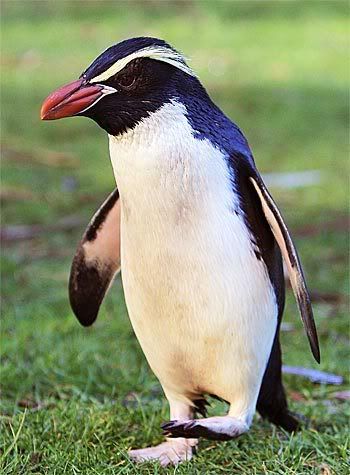
Dyan deNapoli, aka The Penguin Lady, of Georgetown, is organizing a cruise to the Galapogos Islands that is open to the public. Courtesy photo
The Penguin Lady to search for endangered species at equatorBy Katie Farrell
Staff writer
The Daily News
August 18, 2008 11:46 pm
—
GEORGETOWN — Albatrosses, sea lions, frigate birds and blue-footed boobies.
Oh my.
These are just some of the species Dyan deNapoli expects to see on her trip to the Galapagos Islands, but her mission is to witness the endangered Galapagos penguin, perhaps for the last time. She's putting the word out to the public, because there are a few seats left.
Having never been to the Galapagos Islands herself, deNapoli sees the trip as a chance to make a dream come true.
"I've always wanted to go there," she said. "I'm very excited about this trip."
Few can say their dreams include the waddling, flightless birds, but deNapoli has devoted her life to the species.
DeNapoli, 47, of Georgetown, ran the penguin tank at New England Aquarium for nine years, and is now running her own educational business, aptly called The Penguin Lady.
Through the company, she shares facts and knowledge about penguin behavior, biology and conservation in programs geared toward all ages.
In sharing that knowledge, she can also bring penguin fans up close.
DeNapoli will be on board a 10-day cruise through the Galapagos Islands this November and will give presentations about penguins, focusing on the rare and endangered Galapagos penguin that is indigenous to these islands.
The Galapagos are a chain of volcanic islands in the Pacific Ocean along the equator, about 600 miles west of Ecuador.
The cruise is aboard the 190-foot-long luxury class yacht, the M/V Evolution. The Evolution carries just 32 passengers, which makes accommodations more spacious.
Participants will be allowed to get up close and view the aforementioned albatrosses, sea lions, frigate birds, blue-footed boobies, marine iguanas and the endangered Galapagos tortoise in their own environment, as those animals have no fear or threat from humans or human presence, having never been hunted.
As a penguin expert, deNapoli is eager for the opportunity to see the Galapagos penguin. The population of the endangered species is in rapid decline due to the impacts of global warming and El Nino. There are only about 2,500 to 4,500 remaining.
"It might be the last chance I would have to see them; I hope not, but that's a possibility," she said.
An amateur photographer, deNapoli will be packing her camera.
"The photo opportunities there are just beyond comparison," she said.
It won't be her first trip abroad to aid penguins. She's currently writing her first book describing her experience working at a rescue of 20,000 penguins in South Africa after an oil spill in 2000.
There for three weeks, deNapoli said rescue crews worked from sunrise to midnight on the exhaustive mission. The entire rescue took three months and more than 1,200 volunteers, who flew in from all over the world.
"It was the most grueling, intense experience of my entire life," deNapoli said.
The book details the oil spill rescue and her own personal experience responding to it. A portion of the proceeds from book sales are donated to penguin rescue and penguin conservation groups.
While she always wanted to work with animals, deNapoli said she initially intended to work with dolphins. That goal sent her to Hawaii, where she worked as a volunteer on a research expedition and later returned as an intern.
In 1995, she got an internship at the New England Aquarium in the penguin area. It changed the course of events for her.
"I really loved it," she said. "They are pretty engaging animals to work with."
She spent nine years working at the aquarium before leaving to start The Penguin Lady educational company.
Now, she's also a published author who compiled the penguin article for Scholastic Publishing's newest edition of the "New Book of Knowledge" encyclopedia, a book geared toward 7- to 12-year-olds.
A portion of the educational programs that she conducts goes toward penguin rescue groups, as well.
"My mission is to raise both awareness and funding to help protect these unique seabirds and their environment," deNapoli said.
For more information about deNapoli's programs, visit www.thepenguinlady.com.
http://www.newburyportnews.com/punews/local_story_231234654.html/resources_printstory











































